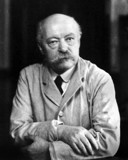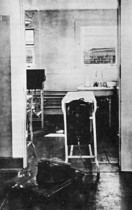The Birth of Modern Surgical Anesthesia

Meltzer, Samuel
Courtesy of the Rockefeller Archive Center
Samuel J. Meltzer (1851-1920) studied the mechanism of respiration in animals with his collaborator John Auer (1875-1948) in the first years after the Rockefeller Institute was founded. They investigated the effect of collapsing the lungs by letting air into the space around the lung (pneumothorax). Remarkably, they discovered that even animals with both lungs collapsed by this process could be kept alive by placing a tube into the windpipe, or trachea, and administering gas under pressure in a manner that kept the lungs continuously expanded and without the normal respiratory movements. They went on to devise a method of delivering inhalation (gas) anesthesia using this technique, which became known as intratracheal insufflation.
Surgeons soon adapted this technique for delivering anesthesia to human patients. Intratracheal insufflation made it easier to do surgery on the face and esophagus. In addition, because intratracheal insufflation provided a simple way to keep the lungs inflated after the chest was opened, surgeons used it during the removal lung tumors and tubercular lesions in the lung, and to perform other surgery of the heart and central blood vessels.

Early machine for intratrachel insufflation. Courtesy of the Rockefeller Archive Center
Samuel Meltzer was born in Russia and trained in Germany, receiving the MD at the University of Berlin in 1882. He emigrated to the United States in 1883. He initially set up a private practice, and paid for the use of research facilities in William H. Welch's laboratory at Bellevue Hospital and Curtis and Prudden's laboratory at the College of Physicians and Surgeons at Columbia University. In 1903 Samuel Flexner invited Meltzer to join the Rockefeller Institute. Meltzer founded or cofounded a remarkable number of professional organizations, including the Harvey Society, the American Society for Clinical Investigation, the Federation of American Societies for Experimental Biology (FASEB), the Society for Experimental Biology and Medicine, and the American Association for Thoracic Surgery; he also served as president of each of these societies, as well as the American Gastroenterology Association, the American Physiological Society, and the Association of American Physicians.

Functional parts of Meltzer's intratracheal insufflation machine. Courtesy of the Rockefeller Archive Center
John Auer received the BS from Michigan University (1898) and the MD from The Johns Hopkins University Medical School (1902). In 1903 he joined Samuel J. Meltzer's laboratory at the Rockefeller Institute. Auer was married to Meltzer's daughter Clara. He became professor of pharmacology at the St. Louis University School of Medicine in 1921. In addition to his work with Meltzer, Auer is remembered for his discovery of Auer bodies, the rod-shaped structures found in the cytoplasm of myoblasts in acute myelocytic leukemia.
Selected Publication
Meltzer SJ and Auer J. Continuous respiration without respiratory movements. J Exp Med, 1909, 11:622
http://www.jem.org/cgi/reprint/11/4/622
Further Reading
Corner GW. A History of the Rockefeller Institute, 1901-1953. New York: Rockefeller Institute Press, 1964
Harvey AM. Samuel J. Meltzer: Pioneer catalyst in the evolution of clinical science in America. Perspect Biol Med, 1978, 21: 431-440
Hurwitz A, ed. Milestones in Modern Surgery. NY: Hoeber-Harper, 1958
Meltzer A. Breath of Life: The Life and Works of Dr. Samuel James Meltzer. NY: Vantage Press, 1993
Meltzer A. Samuel James Meltzer, MD. March 22, 1851-November 7, 1920. Proc Soc Exp Biol Med, 2000, 223: 114-117
http://www.ebmonline.org/cgi/content/full/223/2/114
Scannell, JG. Historical perspectives: Samuel J. Meltzer (1851-1920). J Thorac Cardiovasc Surg, 1996, 111: 905-906
Samuel J. Meltzer (1851-1920): A Biographical Memoir. Washington, DC: National Academy of Sciences, 1921
